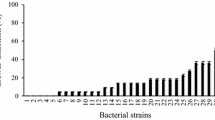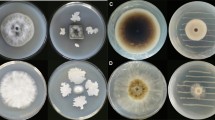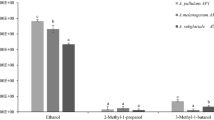Abstract
Volatile organic compounds (VOCs) produced by endophytic strains play important roles in enhancing plant resistance to pathogens; however, the VOCs produced Bacillus mojavensis ZA1 on the inhibiting ability of Colletotrichum coccodes remain unknown. Hence, the effects of VOCs in controlling potato anthracnose (C. coccodes) were investigated. Alcohols, ketones, phenols, and esters were antifungal volatile compounds in the volatile organic compounds (VOCs) produced by B. mojavensis ZA1 after fermentation. The number of VOCs was 29 and 49 at extraction temperatures of 28 °C and 40 °C, respectively. The antifungal activity of 13 of these compounds was tested, and the results showed that 2-ethyl-1-hexanol completely inhibited mycelial growth, sporulation, and conidial germination of C. coccodes. The antifungal activity of VOCs; 2-methyl-1-butanol, 4,4′-(1-methylethylidene) bis-phenol, 2-nitro-ethanol, 2,3-butanediol and 3-methyl-1-butanol was also impressive; not only did they inhibit mycelial growth and spore germination by more than 43%, but they also reduced the pathogen’s conidia production by 43-fold. After studying the structure of organic volatiles with high fungistatic activity, it was predicted that the hydroxyl group could be an effective functional group for B. mojavensis ZA1 to achieve fungal suppression. The antifungal activity of metabolites of alcohols and ketones with 4–8 carbon atoms was superior against pathogenic fungus. As a result, carbon-chain length has been proposed as one of the parameters regulating the fungistatic efficacy of secondary metabolites. By utilizing metabolites produced by B. mojavensis ZA1, this research lays the groundwork for using B. mojavensis ZA1 in biological control.


Similar content being viewed by others

References
Andersen RA, Hamilton-Kemp TR, Hildebrand DF, Mccracken CT, Fleming PD (1994) Structure-antifungal activity relationships among volatile C6 and C9 aliphatic aldehydes, aetones, and alcohols. J Agric Food Chem 42(7):1–5
Asari S, Matzén S, Petersen MA, Bejai S, Meijer J (2016) Multiple effects of Bacillus amyloliquefaciens volatile compounds: plant growth promotion and growth inhibition of phytopathogens. Fems Microbiol Ecol 92(6)
Bi Y, Yu Z (2016) Diterpenoids from Streptomyces sp SN194 and their antifungal activity against Botrytis cinerea. J Agric Food Chem 64(45):8525–8529
Blakeman JP, Hornby D (1966) The persistence of Colletotrichum coccodes and Mycosphaerella ligulicola in soil, with special reference to sclerotia and conidia. Trans Br Mycol Soc 49(2):227–240
Blom D, Fabbri C, Connor EC, Schiestl FP, Klauser DR, Boller T et al (2011) Production of plant growth modulating volatiles is widespread among rhizosphere bacteria and strongly depends on culture conditions. Environ Microbiol 13(11):3047–3058
Chang T, Wang HQ, Yang CD, Xue L, Chen XR, Ren Y et al (2014) Screening and identification of antagonist bacteria against Phoma foveata on potato. Chin J Biol Control 30(2):247–252
Cook A, Stall R (1969) Necrosis in leaves induced by volatile materials produced in vitro by bacteria. Phytopathology 59:259–260
Dhouib H, Zouari I, Ben Abdallah D, Belbahri L, Taktak W, Triki MA et al (2019) Potential of a novel endophytic Bacillus velezensis in tomato growth promotion and protection against Verticillium wilt disease. Biol Control 139
Dong KL, Mo C, Lee DK, Long NP, Kwon SW (2018) Non-destructive profiling of volatile organic compounds using HS-SPME/GC-MS and its application for the geographical discrimination of white rice. J Food Drug Anal 26(1):260–267
Elkahoui S, Djebali N, Yaich N, Azaiez S, Hammami M, Essid R et al (2015) Antifungal activity of volatile compounds-producing Pseudomonas P2 strain against Rhizoctonia solani. World J Microbiol Biotechnol 31(1):175–185
Fang, ZD (1998) Methods of research on plant diseases. 3ed. Beijing: Agricultural Publishing House
Feng B, Chen D, Jin R, Li E, Li P (2022) Bioactivities evaluation of an endophytic bacterial strain Bacillus velezensis JRX-YG39 inhabiting wild grape. BMC Microbiol 22(1)
Frederick ZA, Cummings TF, Brown CR, Quick RA, Johnson DA (2017) Evaluation of Solanum sisymbriifolium as a Potential Inoculum Source of Verticillium dahliae and Colletotrichum coccodes. Plant Dis 101(7):1300–1305
Gotor-Vila A, Teixidó N, Di Francesco A, Usall J, Ugolini L, Torres R et al (2017) Antifungal effect of volatile organic compounds produced by Bacillus amyloliquefaciens CPA-8 against fruit pathogen decays of cherry. Food Microbiol 64:219–225
Hunger RM, McIntyrer GA (1979) Occurrence, development, and losses associated with silver scurf and black dot on Colorado potatoes. Am Potato J 56:289–306
Jayakumar V, Ramesh Sundar A, Viswanathan R (2020) Biocontrol of Colletotrichum falcatum with volatile metabolites produced by endophytic bacteria and profiling VOCs by headspace SPME coupled with GC–MS. Sugar Technol 23(3):94–107
Joo, J, Hussein, K (2022) Biological Control and Plant Growth Promotion Properties of Volatile Organic Compound-Producing Antagonistic Trichoderma spp. Front Plant Sci 13
Kim JD, Kang JE, Kim BS (2020) Postharvest disease control efficacy of the polyene macrolide lucensomycin produced by Streptomyces plumbeus strain CA5 against gray mold on grapes. Postharvest Biol Technol 162
Kudachikar VB, Kumar A (2022) Dose optimisation of volatile molecules-based bio-fungicide product formulations against anthracnose (Colletotrichum coccodes) in tomato fruits. Arch Phytopathol Plant Prot 55(4):474–498
Lee J, Kim WS, Lee Y, Choi Y, Choi H, Jang HW (2019) Solid-phase microextraction arrow for the volatile organic compounds in soy sauce. J Sep Sci 42(18):2942–2948
Lee T, Park D, Kim K, Lim SM, Kim JC (2017) Characterization of Bacillus amyloliquefaciens DA12 showing potent antifungal activity against Mycotoxigenic Fusarium species. Plant Pathol J 33(5):499–507
Lees AK, Brierley JL, Stewart JA, Hilton AJ, Wale SJ, Gladders P et al (2010) Relative importance of seed-tuber and soilborne inoculum in causing black dot disease of potato. Plant Pathol 59(4):693–702
Lees AK, Hilton AJ (2003) Black dot (Colletotrichum coccodes): an increasingly important disease of potato. Plant Pathol 52(1):3–12
Legrifi I, Al Figuigui J, El Hamss H, Lazraq A, Belabess Z, Tahiri A et al (2022) Potential for biological control of pythium schmitthenneri root rot disease of olive trees (Olea europaea L.) by antagonistic bacteria. Microorganisms 10(8)
Lemfack MC, Gohlke B-O, Toguem SMT, Preissner AS, Piechulla B, Preissner R (2018) mVOC 2.0: a database of microbial volatiles. Nucleic Acids Res 46(1):1261–1265
Ling, L, Luo, H, Yang, C, Wang, Y, Cheng, W, Pang, M, et al. (2022) Volatile organic compounds produced by Bacillus velezensis L1 as a potential biocontrol agent against postharvest diseases of wolfberry. Front Microbiol 13
Lodewyckx C, Vangronsveld J, Porteous F, Moore ERB, Taghavi S, Mezgeay M et al (2002) Endophytic bacteria and their potential applications. Crit Rev Plant Sci 21(6):583–606
Lord H, Pawliszyn J (2000) Evolution of solid-phase microextraction technology. J Chromatogr A 885:153–193
Luo L, Zhao C, Wang E, Raza A, Yin C (2022) Bacillus amyloliquefaciens as an excellent agent for biofertilizer and biocontrol in agriculture: an overview for its mechanisms. Microbiol Res 259
Park MS, Ahn JY, Choi GJ, Choi YH, Kim JC (2010) Potential of the volatile-producing fungus Nodulisporium sp. CF016 for the control of postharvest diseases of apple. Plant Pathol J 26(3):253–259
Park YS, Dutta S, Ann M, Raaijmakers JM, Park K (2015) Promotion of plant growth by Pseudomonas fluorescens strain SS101 via novel volatile organic compounds. Biochem Biophys Res Commun 46(2):361–365
Pérez-Mora JL, Cota-Rodríguez DA, Rodríguez-Palafox EE, García-León E, Beltrán-Peña H, Lima NB et al (2020) First confirmed report of Colletotrichum coccodes causing black dot on potato in Mexico. J Plant Dis Prot 127(2):269–273
Rajer FU, Wu HJ, Xie YL, Xie SS, Raza W, Tahir HAS et al (2017) Volatile organic compounds produced by a soil-isolate, Bacillus subtilis FA26 induce adverse ultra-structural changes to the cells of Clavibacter michiganensis ssp. sepedonicus, the causal agent of bacterial ring rot of potato. Microbiology 163(4):523–530
Rath M, Mitchell TR, Gold SE (2018) Volatiles produced by Bacillus mojavensis RRC101 act as plant growth modulators and are strongly culture-dependent. Microbiol Res 208:76–84
Risticevic S, Lord H, Górecki T, Arthur CL, Pawliszyn J (2010) Protocol for solid-phase microextraction method development. Nat Protoc 5(1):122–139
Sui, XN, Han, XB, C, JM, Li, YQ Yuan, Y, Jian, Y, et al. (2022) Biocontrol potential of Bacillus velezensis EM-1 associated with suppressive rhizosphere soil microbes against tobacco bacterial wilt. Front Microbiol 13
Tahir HAS, Gu Q, Wu HJ, Raza W, Hanif A, Wu LM et al (2017) Plant growth promotion by volatile organic compounds produced by Bacillus subtilis SYST2. Front Microbiol 8
Toffano L, Fialho MB, Pascholati SF (2017) Potential of fumigation of orange fruits with volatile organic compounds produced by Saccharomyces cerevisiae to control citrus black spot disease at postharvest. Biol Control 108:77–82
Tsror Lahkim L, Erlich O, Hazanovsky M (1999) Effect of Colletotrichum coccodes on Potato yield, tuber quality, and stem colonization during spring and autumn. Plant Dis 83(6):561–565
Vespermann A, Kai M, Piechulla B (2007) Rhizobacterial volatiles affect the growth of fungi and Arabidopsis thaliana. Appl Environ Microbiol 73(17):5639–5641
Wanasinghe WUT, Damunupola JW (2020) Effect of UV-C hormesis in regulating anthracnose disease and postharvest quality of tomato. J Agric Sci-Sri Lanka 15(3):318–327
Yang CD, Chang T, Xue L, Feng ZH, Yao YL, Li T et al (2015) Optimizing the culture conditions and determining the stability of antibiotic secretion by Polygonum viviparum of the endophytic bacteria Bacillus mojavensis. Acta Pratacul Sin 24(9):104–112
Yin N, Liu R, Zhao JL, Khan R, Mao Z (2020) Volatile organic compounds of Bacillus cereus strain Bc-cm103 exhibit fumigation activity against Meloidogyne incognita. Plant Dis 105(4):904–911
Zhang D, Yu S, Yang Y, Zhang J, Zhu J (2020) Antifungal effects of volatiles produced by Bacillus subtilis against Alternaria solani in potato. Front Microbiol 11
Zhang Y, Feng ZL, Feng HJ, Li ZF, Shi YQ, Zhao LH et al (2016) Control effect of endophytic fungus Chaetomium globosum CEF-082 against Verticillium wilt in Gossypium hirsutum. Acta Phytopathol Sin 46(5):697–706
Zhao PY, Li PZ, Wu SY, Zhou MS, Zhi RC, Gao HY (2019) Volatile organic compounds (VOCs) from Bacillus subtilis CF-3 reduce anthracnose and elicit active defense responses in harvested litchi fruits. AMB Express 9:1–13
Zhao SL, Ren FE, Liu JL, Qin JC, Pan HY (2012) Screening, identification and optimization of fermentation conditions of an antagonistic actinomycetes strain to Setosphaeria turcica. Acta Microbiol Sin 52(10):1228–1236
Zhong L, Li LH, Zheng YL, Zhou YX, Zeng YL, Zhu WH et al (2022) First report of black dot caused by Colletotrichum coccodes on potato in the Tibet autonomous Region of China. Plant Dis 106
Acknowledgements
This study was supported by the project of the National Natural Science Foundation of China (No: 31660148) and by the Science and Technology Innovation Fund of Gansu Agricultural University (No. GAU-XKJS-2018-148) from Gansu Agricultural University to Prof. Chengde Yang.
Author information
Authors and Affiliations
Corresponding author
Ethics declarations
Conflict of interest
The authors declare no conflict of interest. Each of the authors of the study is aware of and agrees with the submission of this paper.
Ethical approval
The authors solemnly promise that the research meets ethical standards.
Additional information
Publisher's Note
Springer Nature remains neutral with regard to jurisdictional claims in published maps and institutional affiliations.
Rights and permissions
Springer Nature or its licensor (e.g. a society or other partner) holds exclusive rights to this article under a publishing agreement with the author(s) or other rightsholder(s); author self-archiving of the accepted manuscript version of this article is solely governed by the terms of such publishing agreement and applicable law.
About this article
Cite this article
Wei, L., Fan, L., Yang, C. et al. Analysis of Bacillus mojavensis ZA1 volatile anti-pathogen substances against Colletotrichum coccodes. J Plant Dis Prot 130, 633–642 (2023). https://doi.org/10.1007/s41348-023-00717-9
Received:
Accepted:
Published:
Issue Date:
DOI: https://doi.org/10.1007/s41348-023-00717-9



